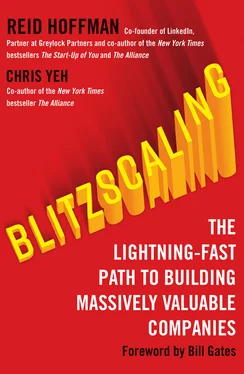Whether you are a founder, a manager, a potential employee, or an investor, we believe that understanding blitzscaling will allow you to make better decisions in a world where speed is the critical competitive advantage.
With the power of blitzscaling, the adopted son of a Syrian immigrant (Steve Jobs), the adopted son of a Cuban immigrant (Jeff Bezos), and a former English teacher and volunteer tour guide (Jack Ma) were all able to build businesses that changed—and are still changing—the world.
The strategy and techniques we describe in this book are based on my experiences as a member of the founding team at PayPal; as the cofounder, CEO, and now executive chairman at LinkedIn; as a leading investor in Facebook and Airbnb; and as an investor at Greylock Partners, where I worked with many other billion-dollar companies, such as Workday, Pandora, Cloudera, and Pure Storage. My partners at Greylock and I have helped these companies go from garage to global dominance, and, in this book, we’ll share with you what we believe are important frameworks for understanding and addressing the challenge of blitzscaling across the different elements of your organization.
Yet as many good business books disclaim, while this is a playbook and a strategy guide, it isn’t a book of precise recipes. Regardless of how the popular press portrays things, each formula for building a great company is unique and depends on the market opportunity, the founders, and the network in which they operate. The truth is there is absolutely nothing guaranteed as a one-size-fits-all, must-follow rule book for everyone. However, there are patterns. So in addition to individual tips and tricks, this book offers a set of frameworks and strategies for leaders, entrepreneurs, and intrapreneurs to adapt to their own needs and circumstances.
A QUICK NOTE ON THE TERM “BLITZSCALING”
The term “blitzscaling” derives from the twentieth-century usage of “blitz” as a way of describing a sudden, all-out effort. The first usage of blitz in this way was to describe the “blitzkrieg” (“lightning war”) strategy that General Heinz Guderian devised for the initial military campaigns of Nazi Germany during World War II. Ironically enough, Guderian was heavily influenced by British military thinkers like Basil Liddell Hart and J. F. C. Fuller, and the term “blitzkrieg” was actually popularized by the British press; the German military never formally adopted it.
The advancing armies in these campaigns abandoned the traditional approach of moving at the slow pace at which they could establish secure lines of supply and retreat. Instead they fully committed to an offensive strategy that accepted the possibility of running out of fuel, provisions, and ammunition, risking potentially disastrous defeat in order to maximize speed and surprise. The speed of these armies’ advance shocked and overwhelmed their opponents, allowing the blitzkriegers to outmaneuver and outfight the defending forces.
The early success of the German army helped spread the lessons of blitzkrieg to all the forces in the war. For example, the American general George S. Patton later put these lessons to good use in leading the US Third Army’s advance from the beaches of Normandy all the way to Berlin. Since then, the term “blitz” has been used to describe everything from an American football play to the way in which large corporations roll out new products. Like the all-out blitz defense in football—which involves the risky move of sending every available defender to pursue the quarterback—or the proverbial marketing blitz of television, print, and online advertising that accompanies the release of a new blockbuster movie, blitzscaling strives for a relentless and dizzying speed that overwhelms the market.
While we are wary of the negative connotations of “blitz,” especially in those nations that felt the effects of blitzkrieg in World War II, we believe that the strength of the metaphor and the widespread and colloquial use of the term in nonmilitary contexts make it the best fit for the concepts discussed in this book.
PART I
What Is Blitzscaling?
Blitzscaling is what we call both the general framework and the specific techniques that allow companies to achieve massive scale at incredible speed. If you’re growing at a rate that is so much faster than your competitors that it makes you feel uncomfortable, then hold on tight, you might be blitzscaling!
Amazon’s incredible growth in the late 1990s (and up through today) is a prime example of blitzscaling. In 1996, a pre-IPO Amazon Books had 151 employees and generated revenues of $5.1 million. By 1999, the now-public Amazon.com had grown to 7,600 employees and generated revenues of $1.64 billion. That’s a 50 times increase in staff and a 322 times increase in revenue in just three years. In 2017, Amazon had 541,900 employees and was forecast to generate revenues of $177 billion (up from $136 billion in 2016).
Dropbox founder Drew Houston described the feeling produced by this kind of growth when he told me, “It’s like harpooning a whale. The good news is, you’ve harpooned a whale. And the bad news is, you’ve harpooned a whale!”
While blitzscaling may seem desirable, it is also fraught with challenges. Blitzscaling is just about as counterintuitive as it comes. The classic approach to business strategy involves gathering information and making decisions when you can be reasonably confident of the results. Take risks, conventional wisdom says, but take calculated ones that you can both measure and afford. Implicitly, this technique prioritizes correctness and efficiency over speed.
Unfortunately, this cautious and measured approach falls apart when new technologies enable a new market or scramble an existing one.
Chris earned his MBA from Harvard Business School in the late 1990s, during the dawn of the Networked Age. Back then, his MBA training focused on traditional techniques, such as using discounted cash flow analysis to make financial decisions with greater certainty. Chris also learned about traditional manufacturing techniques, such as how to maximize the throughput of an assembly line. These methods focused on achieving efficiency and certainty, and the same emphasis was reflected in the broader business world. The world’s most valuable company during that time, General Electric, was beloved by Wall Street analysts for its ability to deliver consistent and predictable earnings growth. But efficiency and certainty, while innately appealing, and very important in the context of a stable, established market, offer little guidance to the disrupters, inventors, and innovators of the world.
When a market is up for grabs, the risk isn’t inefficiency—the risk is playing it too safe. If you win, efficiency isn’t that important; if you lose, efficiency is completely irrelevant. Over the years, many have criticized Amazon for its risky strategy of consuming capital without delivering consistent profits, but Amazon is probably glad that its “inefficiency” helped it win several key markets—online retail, ebooks, and cloud computing, to name just a few.
When you blitzscale, you deliberately make decisions and commit to them even though your confidence level is substantially lower than 100 percent. You accept the risk of making the wrong decision and willingly pay the cost of significant operating inefficiencies in exchange for the ability to move faster. These risks and costs are acceptable because the risk and cost of being too slow is even greater. But blitzscaling is more than just plunging ahead blindly in an effort to “get big fast” to win the market. To mitigate the downside of the risks you take, you should try to focus them—line them up with a small number of hypotheses about how your business will develop so that you can more easily understand and monitor what drives your success or failure. You also have to be prepared to execute with more than 100 percent effort to compensate for the bets that don’t go your way.
Читать дальше












